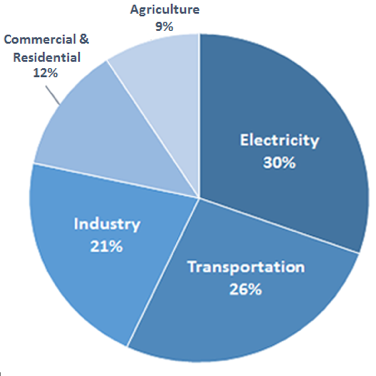
Colin Lacey leads Product Management and Marketing for MTPV with more than 25 years of experience in product management, services creation, and business development in both global Fortune 500 companies and emerging market technology companies.
The National Oceanic and Atmospheric Administration (NOAA) has been tracking the levels of carbon dioxide (CO2) in the atmosphere since the 1950s from the Manua Loa Observatory in Hawaii. While there is a predictable fluctuation in the month-to-month readings on an annual cycle, the overall trend has been an almost perfectly linear increase over time. The data shows that September is typically the annual low point for CO2 readings, but in 2016 the September readings exceeded 400ppm for the first time, resulting in the first full year cycle with readings consistently above 400ppm (1).
CO2 and other greenhouse gasses (GHGs) such as methane, nitrous oxide, hydrofluorocarbons and others, collectively known as CO2 equivalents, trap heat in the atmosphere resulting in climate change. NASA notes that global climate change has already had a directly observable effect on the environment with shrinking glaciers, the shifting of plant and animal ranges, and altered flowering cycles. Humans are experiencing these changes with accelerated sea level rise and longer, more intense heat waves.

CO2 emissions come from transportation, industry, commercial & residential, and agricultural activities. The largest single contributor to emissions in the U.S., however, is the generation of electricity, emitting 30% of the total (2). In response to this, the EPA’s Clean Power plan has established an ambitious goal of cutting GHG emissions to 70% of 2005 levels by 2030, and initial energy industry plans for compliance are due this year (subject to ongoing litigation). The imperative to reverse our current direction is clear – CO2 is removed from the atmosphere by natural processes at roughly half of the current rate of emissions from human activities, so efforts that only stabilize global emissions will not reduce the levels of GHGs in the atmosphere, just limit their rate of increase (3).

So what does MTPV offer to contribute to the reversal of this pressing trend?
Implementing the MTPV EBLADETM Power Platform results in the reduction of both CO2 and CO2 equivalent emissions by reducing the energy demands on traditional on-grid power plants and by reducing the use of on-site diesel-powered generators in off-grid applications. In the U.S., grid-based electricity sources emit an average of 1.222lbs of CO2 per kWh produced (4). That equates to 5190 metric tons of CO2 annually per megawatt of power. In off-grid situations, where the site is generating power using traditional diesel generators with significantly lower efficiency and emissions controls than are achievable at an on-grid power plant, the positive environmental impact of the EBLADETM Power Platform is amplified.
MTPV solutions not only reduce the emissions of CO2 and its equivalents but also reduce the thermal emissions of both the heat source site and its on-grid power supplier. For each megawatt of electricity produced by MTPV annually, we remove almost 30 billion British thermal units (Btus) of heat emissions from the waste heat source (which would otherwise vent into the atmosphere) and avoid the creation of twice that heat being emitted from a power plant, a net positive impact of roughly 90 billion Btus per megawatt annually.

CO2 emissions are a global challenge, and as new economies enter a rapid growth phase we have seen their emissions scale accordingly, easily outpacing the investment and effort made in more mature economies to curtail the growth of, or even reduce, their emissions. The simple fact is that our atmosphere is not constrained by borders or economies, and therefore a concerted global effort is warranted to contain the effects of global climate change. While a wide array of approaches will be required to reverse the trajectory of our atmosphere’s CO2, I am encouraged by the prospect that clean electricity from MTPV’s technology can contribute strongly to the solution of this pressing challenge.
(1) https://scripps.ucsd.edu/programs/keelingcurve/2016/09/23/note-on-reaching-the-annual-low-point/
(2) https://www.epa.gov/ghgemissions/us-greenhouse-gas-inventory-report-1990-2014
(3) http://nca2014.globalchange.gov
(4) https://www.epa.gov/energy/egrid

